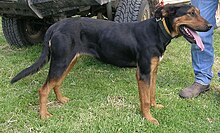New Zealand Huntaway

A New Zealand Huntaway
|
|||||||||||||||||||||||||
| Other names | New Zealand Huntaway New Zealand Sheepdog |
||||||||||||||||||||||||
|---|---|---|---|---|---|---|---|---|---|---|---|---|---|---|---|---|---|---|---|---|---|---|---|---|---|
| Origin | New Zealand | ||||||||||||||||||||||||
|
|||||||||||||||||||||||||
|
|||||||||||||||||||||||||
| Notes | may be registered with the New Zealand Sheepdog Trial Association | ||||||||||||||||||||||||
| Domestic dog (Canis lupus familiaris) | |||||||||||||||||||||||||
| Traits | |||
|---|---|---|---|
| Weight | 25–40 kilograms (55–88 lb) | ||
| Height | 56–66 centimetres (22–26 in) | ||
| Coat | smooth or rough (grizzled) | ||
| Color | variable, commonly black and tan, tricolour | ||
| Life span | 12-14 years | ||
| Classification / standards | |||
|---|---|---|---|
| NZKC | Working | standard | |
The Huntaway is a large, strongly built breed of dog used for general sheep herding tasks in New Zealand, where they originate. They were bred to use their loud, deep bark to drive sheep.
The breed is relatively new, dating from the late 19th century, and distinguished only on working ability. There is no prescribed appearance or lineage but they are usually black and tan coloured. Only dogs that win at trials may be registered by the New Zealand Sheep Dog Trial Association in their studbook.
Huntaways are large, deep-chested dogs that generally weigh in the region of 25–45 kilograms (55–99 lb). Their coats can vary in colour; colours include black, black and tan (usually) with some white or brindle. Their coats can also come in different textures; they can be smooth, rough, or grizzly and they are generally floppy eared. A huntaway’s height is usually in the range of 56–66 centimetres (22–26 in).
They are required to have great intelligence, agility and stamina for days of working on steep, rough country over large distances, driving very large mobs of sheep. Their bark is deep and repeating, usually with a short pause between barks, which allows the barking to be sustained for very long periods.
The huntaway was developed as a breed in response to farming conditions found in the New Zealand high country. The vast pastoral runs or "stations", such as those in the high country of the South Island, required teams of dogs who could work mustering for days on end, covering great distances on rough steep country. High country stations typically cover many thousands of hectares, and were often unfenced. British sheepdogs used by early New Zealand farmers mostly worked sheep silently, but occasionally a dog would use its bark to herd sheep. This characteristic was liked by some farmers, especially for driving sheep on rough, steep hill country where a dog may disappear from view, making a dog that drives stock by sight less useful. Collies and other working sheepdogs with the barking trait would have been crossed with any other breed that had other desirable traits, including size, stamina and a steady barking ability, as these are the traits that differentiate the huntaway from the heading dog today, but the exact lineage is not known.
The earliest references to huntaways are in the late 19th century. A sheepdog trial with a specific class for huntaways was advertised in the Upper Waitaki in 1870. "Wanted" advertisements for "huntaway sheepdogs" were in the Otago Daily Times newspaper in 1884, heading and huntaway collies were advertised for sale in 1885. The huntaway was further developed as a separate breed from the heading dog during the 20th Century.
...
Wikipedia
